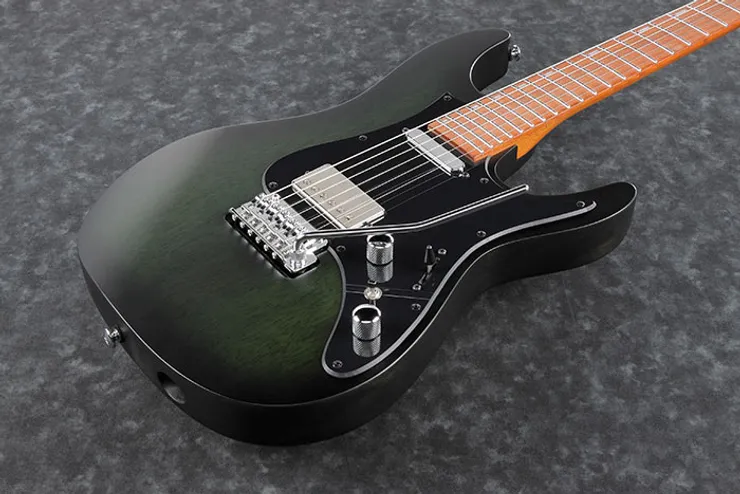While we’re transitioning into the next generation of tonewoods, plenty of great options are becoming more popular with guitar makers and players alike. One of which is nato, which offers its own take on mahogany’s outstanding characteristics. Or is it nyatoh?
What Is Nato?
Nato is a collective name for the Mora genus of trees. Native to South and Central America and some Caribbean islands, it is a tough wood with a Janka hardness rating of 2,300. Given its hardness, nato makes an excellent choice for heavy-duty flooring and exterior construction.
What Is Nyatoh?
As with nato, nyatoh wood doesn’t come from just one tree species but includes several species from two different genera – Palaquium and Payena. Nyatoh is much lighter than nato and has a Janka rating of 1070-1170 depending on the species; softer than true nato but still harder than mahogany. And speaking of mahogany, nyatoh wood shares many of the classic tonewood’s characteristics. So much so that it is sometimes known as ‘Eastern mahogany’.
Nyatoh is a trading name used in the timber industry to describe wood from a collection of similar species. But, to complicate things, someone decided to also call it nato somewhere down the line, even though it’s completely unrelated to the existing nato wood!
How Is Nato Used in Guitars?
Generally speaking, guitar makers don’t use true nato (that is, wood from the mora genus). Given its hardness and weight, it’s unsuitable for most components. It could be an option for fretboards, where nato’s hardness would easily cope with wear and tear from strings. But, as plenty of better fretboard options are readily available, luthiers never really consider it even for that purpose.
How is Nyatoh Used in Guitars?
Nyatoh, on the other hand, is undoubtedly a suitable option for guitar construction. With plenty of physical similarities to mahogany, nyatoh can serve admirably as a solid body for electric guitars and basses. It’s also an excellent choice for necks or even for the back and sides of acoustic and hollow body guitars.
Hopefully, that clears up the difference between nato and nyatoh! Now that we’ve established that true nato is not really a suitable guitar wood, it’s time to say goodbye to nato while we focus on nyatoh for the rest of this article.
Remember: when you’re shopping for guitars and see nato listed in the guitar’s specification, it’s nyatoh!
Is Nyatoh a Good Wood for Guitars?
Many people consider nyatoh a cheap tonewood, and it’s true that it predominantly appears in more budget-conscious models. But debate over how good nyatoh sounds compared to other woods is divided mainly between those who swear mahogany is significantly better and those who can’t tell any difference. The difference is especially irrelevant when considering electric guitars, as much of the tone you will hear results from the guitar’s pickups.
How Do Nyatoh Guitars Sound?
We’ve already mentioned the physical similarities between nyatoh and mahogany. So it may come as no surprise that nyatoh is also closest to mahogany in terms of tonal qualities. To the trained ear, mahogany will likely have more warmth and resonance. But nyatoh offers a similar mid-range profile that will please most fans of mahogany guitars.
Are Nyatoh Guitars Durable?
With an average Janka rating of over 1,000, nyatoh is durable enough to put up with plenty of use. When we compare it to other tonewoods, it is a little harder than Honduran mahogany and significantly more so than alder. However, nyatoh isn’t quite as hard as rosewood, for instance.
Guitar Maintenance
As a reasonably typical guitar wood, you can treat your nyatoh guitar just like you would any other:
*Store your guitar at a steady temperature and humidity (40-60%, ideally).
*Clean with a good quality polish.
*Dust with a non-abrasive microfibre cloth.
*Store it in a padded case when you aren’t riffing.
Is Nyatoh Sustainable?
As nyatoh comes from various tree species in the Palaquium and _Payena _genera, plenty of options are available, and Nyatoh doesn’t appear in the CITES Appendices. That said, some of these species are currently listed on the IUCN Red List, which cites declining populations due to overharvesting. Most species involved in the production of nyatoh are not at risk for the foreseeable future. However, it could be a different story if harvesting continues unchecked.
What Are the Pros and Cons of Nyatoh Guitars?
| Pros | Cons |
|---|---|
| Cheaper wood | Quite a drab appearance |
| Good mid-range response | Not as good warmth or sustain as mahogany |
| Fairly good resonance | Not commonly seen in more premium instruments |
| Good durability |
Nyatoh Tonewood Alternatives
If you’re looking for an even better mid-range tonal performance or more warmth, mahogany is the obvious way to go, or maybe consider sapele. Alternatively, for more treble, maybe think about incorporating maple. Or, if you want a more well-rounded tone with solid performance across the board, look at alder.
Find Your Guitar
If you’re ready to go all in on a nyatoh guitar, why not try our Finder tool? Enter all of the must-haves for your perfect axe, such as pickups, tonewood, and price range, and start searching for your next guitar.

